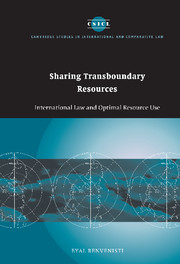Book contents
- Frontmatter
- Contents
- Acknowledgments
- Table of cases
- List of abbreviations
- 1 Introduction
- 2 The need for collective action in the management of transboundary resources
- 3 States as collective actors
- 4 The transnational conflict paradigm: structural failures and responses
- 5 Transnational institutions for transboundary ecosystem management: defining the tasks and the constraints
- 6 The structure and procedure of institutions for transboundary ecosystem management
- 7 The development of positive international law on transboundary ecosystems: a critical analysis
- 8 Efficiency, custom, and the evolution of international law on transboundary resources
- 9 Conclusion
- Bibliograhy
- Index
- CAMBRIDGE STUDIES IN INTERNATIONAL AND COMPARATIVE LAW
9 - Conclusion
Published online by Cambridge University Press: 14 July 2009
- Frontmatter
- Contents
- Acknowledgments
- Table of cases
- List of abbreviations
- 1 Introduction
- 2 The need for collective action in the management of transboundary resources
- 3 States as collective actors
- 4 The transnational conflict paradigm: structural failures and responses
- 5 Transnational institutions for transboundary ecosystem management: defining the tasks and the constraints
- 6 The structure and procedure of institutions for transboundary ecosystem management
- 7 The development of positive international law on transboundary ecosystems: a critical analysis
- 8 Efficiency, custom, and the evolution of international law on transboundary resources
- 9 Conclusion
- Bibliograhy
- Index
- CAMBRIDGE STUDIES IN INTERNATIONAL AND COMPARATIVE LAW
Summary
This book's first objective is to outline conditions for collective action in the management of transboundary resources, especially transboundary ecosystems. For that purpose, the book analyzes how states shape their preferences in the transnational competition over resources. Observation of state practice leads to the second goal of the book: to explain why states fail to act together with their neighbors to protect their shared resources, and suggests how these failures could be corrected. This goal leads to the third step in the inquiry: to examine what responses international law has to offer for inducing states to opt for cooperation. The divergence within contemporary international law, particularly the clash between two conflicting approaches – “the philosophy of disengagement” and “the philosophy of integration” – calls for a final insight: international tribunals, particularly the International Court of Justice (ICJ), are authorized to develop international law in accord with the goal of efficiency.
In exploring the potential for collective state action, this book breaks away from the distinction between domestic and international processes. The systemic failures of states that derive from their heterogeneity in their management of natural resources affect similarly domestic and international resources. Domestic conflicts of interest – between farmers and city dwellers, between producers and consumers – are responsible for distorted governmental choices, whether on the domestic or the international level. In fact, many domestic interest groups cooperate with foreign interest groups in order to impose their externalities on their respective rival domestic groups.
- Type
- Chapter
- Information
- Sharing Transboundary ResourcesInternational Law and Optimal Resource Use, pp. 232 - 235Publisher: Cambridge University PressPrint publication year: 2002

